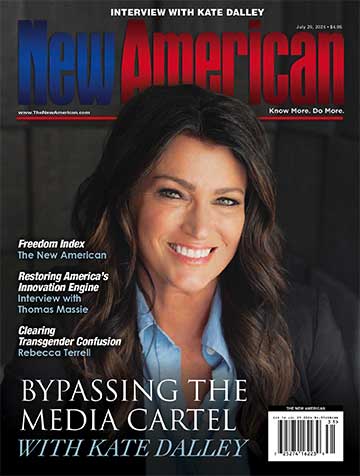
Do you remember the apocalyptic Asian Flu pandemic of 1957 and 1958?
Writing for the American Institute for Economic Research, Jeffrey Tucker notes that no one else remembers it either.
This is somewhat surprising, and even revelatory, in light of the current COVID panic. This is primarily because, as Tucker notes, that earlier pandemic was just as bad or worse than our present pandemic.
“The Asian Flu of 1957-1958 was a deadly pandemic with a broader reach for severe outcomes than Covid-19 of 2020,” Tucker writes. “It killed between 1 and 4 million people worldwide, and 116,000 in the US in a time with half the population. It was a leading contributor to a year in which the US saw 62,000 excess deaths.”
Aside from the deaths caused by that earlier pandemic, there are other parallels.
As Tucker notes, among the best peer-reviewed articles on the subject of this earlier pandemic was written by Donald A. Henderson, Brooke Courtney, Thomas V. Inglesby, Eric Toner, and Jennifer B. Nuzzo, and it appeared in the journal Biosecurity and Bioterrorism in 2009. That article gives us a sense of the similarities of the earlier pandemic with today’s.
For example, the emergence of that earlier pandemic mirrors the emergence of the modern version. “In February 1957, a new influenza virus (H2N2), called the ‘Asian strain,’ emerged in China,” Henderson and his coauthors wrote. “It subsequently spread to Hong Kong in April and through eastern Asia and the Middle East in April, May, and June. By June, more than 20 countries, including the U.S., had experienced their first cases. South American and African countries were afflicted in July and August. In September, widespread epidemics began in North America and Europe.”
Moreover, the virus spread rapidly, most symptoms were mild or non-existent and many people were exposed, and developed antibodies, without knowing they’d caught the virus. “Serological surveys revealed that half of those reporting no influenza illness showed serological evidence of infection,” Henderson and his coauthors noted.
The most interesting comparison of then versus now, as Tucker notes, is the divergent strategies pursued by public health agencies. Today, the approach is to deploy heavy-handed lockdowns and other invasive policies that cause a proliferation of other harms piled on top of those caused by the virus alone. This didn’t happen in the late 1950s attempt to deal with the Asian Flu virus.
As Tucker points out, “The most influential public health body at the time was the Association of State and Territorial Health Officers (ASTHO). They met on August 27, 1957. They concluded that they should recommend home care as much as possible to keep the hospitals from overcrowding. They would instruct people to seek medical attention if symptoms become severe.”
Importantly they didn’t recommend closures of business and lockdowns. Henderson and his colleagues write: “At the meeting, ASTHO also stated that ‘there is no practical advantage in the closing of schools or the curtailment of public gatherings as it relates to the spread of this disease.’ This was in recognition that they saw no practical means for limiting the spread of infection.” (Emphasis added in Henderson.)
Despite the fact that the 1957-1958 flu pandemic was comparable in severity to the current COVID pandemic, neither the United States nor the world as a whole took much notice of it. None of the words “influenza,” “flu,” “pandemic,” “outbreak,” “disease,” or “sickness” make an appearance, for example, in journalist and historian David Halberstam’s 733-page history of the decade. Instead, despite the problems that that decade faced, which are well-chronicled by Halberstam, he nonetheless described the 1950s in terms that likely align with the popular perception of the period.
It was a time when “most Americans were optimistic about the future,” Halberstam wrote in The Fifties. “Young men who had spent three or four years fighting overseas were eager to get on with their lives; so too were the young women who had waited for them at home. The post-World War II rush to have children would later be described as the ‘baby boom.’ (Everything else in the United States seemed to be booming, so why not the production of children as well?) It was a good time to be young and get on with family and career: Prices and inflation remained relatively low; and nearly everyone with a decent job could afford to own a home. Even if the specter of Communism lurked on the horizon — particularly as both superpowers developed nuclear weapons — Americans trusted their leaders to tell them the truth, to make sound decisions, and to keep them out of war.”
What an age that must have been! A veritable Utopia realized. Nonetheless it was an imperfect age, as they all are, but it was far better than most. And, of note, public health authorities were generally interested in pursuing policies that would protect without destroying. It was not an absolutist age, unlike our own, when the lust for power drives technocrats and oligarchs to instill fear and incite divisiveness in an effort to impose their rule at will.
Henderson and his collaborators wrap up their survey of the 1957-1958 pandemic with the observation that the government response, simply, was to do nothing.
The 1957-58 pandemic was such a rapidly spreading disease that it became quickly apparent to U.S. health officials that efforts to stop or slow its spread were futile. Thus, no efforts were made to quarantine individuals or groups, and a deliberate decision was made not to cancel or postpone large meetings such as conferences, church gatherings, or athletic events for the purpose of reducing transmission. No attempt was made to limit travel or to otherwise screen travelers. Emphasis was placed on providing medical care to those who were afflicted and on sustaining the continued functioning of community and health services. The febrile, respiratory illness brought large numbers of patients to clinics, doctors’ offices, and emergency rooms, but a relatively small percentage of those infected required hospitalization.
http://www.upmc-biosecurity.org/website/resources/publications/2009/2009-08-05-public_health_medical_responses_1957.html
Many died, unfortunately. But as Henderson concludes, “25% of the U.S. population became ill with influenza, and excess mortality due to pneumonia and influenza occurred. From one watching the pandemic from very close range, though, it was a transiently disturbing event for the population, albeit stressful for schools and health clinics and disruptive to school football schedules.”
COVID may be caused by a different virus, but its overall health impact is comparable. We should wonder, then, in our supposedly more advanced, scientifically enlightened age, why our government authorities have performed so poorly by comparison to those of that much different age now more than half-a-century ago.



